This month’s B2B will focus on an existing datacom room located within a 200,000-sq-ft financial business office building. The existing datacom room is being expanded from 10,000 sq ft to 20,000 sq ft. This existing interior room has a class A1 environment and shall remain class A1 with the expansion project. Room shall remain at 78˚F +/- 2˚F and 40% relative humidity +/- 5%.
The existing building central chilled water plant is adequate to accommodate the increased chilled water demand so no changes are required within the central chiller plant. To select the optimum computer room air handling (CRAH) units, much of the selection criteria was already determined when the building program and the basis of design were approved by the building owner: 1) Match the existing, standardized 20-ton CRAH units. 2) Match the existing design parameters e.g., chilled water supply and return temperatures. 3) Provide N+2 CRAH units within the datacom room.
The designer engineer is directed to 2015 ASHRAE Handbook— HVAC Applications, chapter 19 (Data Centers and Telecommunication Facilities) and chapters 36 through 43 (Building Operation and Management).
Project delivery method shall be integrated project delivery (IPD) based on 2015 ASHRAE Handbook — HVAC Applications, chapter 58 (Integrated Building Design). The IPD team shall include the owner, building facility manager, owner representative and commissioning and air and water balancing consultant, HVAC consultant engineer as the design team leader, architect, electrical, plumbing, telecommunication, fire protection, and security subconsultants, general contractor and HVAC, electrical, and telecommunication subcontractors. The building’s central plant manager and her O&M staff will also participate in the IPD process, beginning at the conceptual phase.
For this month’s HVAC application, the equipment selection are change to 6-20 ton CRAH units to be installed within the Datacom room, each unit furnished with a chilled water coil. Coils shall be connected to the existing chilled water distribution loop above the ceiling where existing valve and capped isolation valves had been installed when the original room was built. The chilled water shall be 46˚F CHWS and 56˚F CHWR with 14-ft pressure drop through the unit’s cooling coils. CRAH fans shall be direct drive plug fans with integral variable speed fan control. Supply air discharge shall be downflow into a 24-in high floor plenum. Airflow will be a combination of hot-aisle and rack-based containment with a ceiling return plenum.
Each unit shall be furnished with MERV 8-35% efficient filters and ultrasonic humidifier.
Electrical shall be 480/3/60 electrical power to unit pre-wired automatic controls, humidifier, and fans. A factory-installed control logic panel should have an interface to the other CRAH units and internet access to each control panel for remote control troubleshooting and alarms and safety signal.
Unit shall be furnished with all required temperature and pressure gages, water strainers, flow switches, safety controls and alarms, and shutoff valves. HVAC subcontractor shall rig units into place, field install associated chilled water piping and drain piping, insulation, and sheet metal duct distribution. Chilled water piping shall be schedule 40 steel, with insulation thickness per the State Energy code. City water makeup shall be by plumbing subcontractor.
The IPD team shall begin to come together at Phase 2 Project Initiative and include with the owner, facility manager, owner representative, design team leader (HVAC consultant engineer), architect, and general contractor. The remaining IPD team members will be brought on board at Phase 3 Concept Development The IPD team shall produce Concept Documents and Design Documents (drawings and specifications). The Phase 5 Construction Preparation; Phase 6 Construction; Phase 7 Owner Acceptance; and Phase 8 Use, Operate, and Maintain shall follow.
The IPD team shall complete a computational fluid dynamic (CFD) analysis, as well as complete a hydraulic model of the entire chilled water system (new and existing). The O& M personnel review the documents, beginning with the concept development phase, and observe equipment startup, air and water balancing, and commissioning system demonstration.
The IITD team’s general contractor shall include the following during the shop drawing submittal phase:
- Equipment submittals - Pump & fan curves - Startup sheet –Troubleshooting sheets - O&M manuals, parts, and lubricants –ATC and energy management submittal, including one complete ATC submittal integrating manufacturer’s CRAH unit-furnished ATC into an integrated overall ATC submittal.
The IPD owner representative shall provide third-party commissioning and testing/adjusting/balancing (CxTAB) services as following:
- TAB system flow diagram of entire (new and existing) chilled water system with GPMs and pump heads indicated at each piece of equipment. TAB flow diagrams shall also be completed for each new CRAH air distribution cfm at hot-aisle and racked-based containment and return air.
- Commissioning functional performance test of HVAC systems (chilled water and new CRAH air distribution). Refer to this month’s “Facility Files” for additional information pertaining to completing the B2B test.




